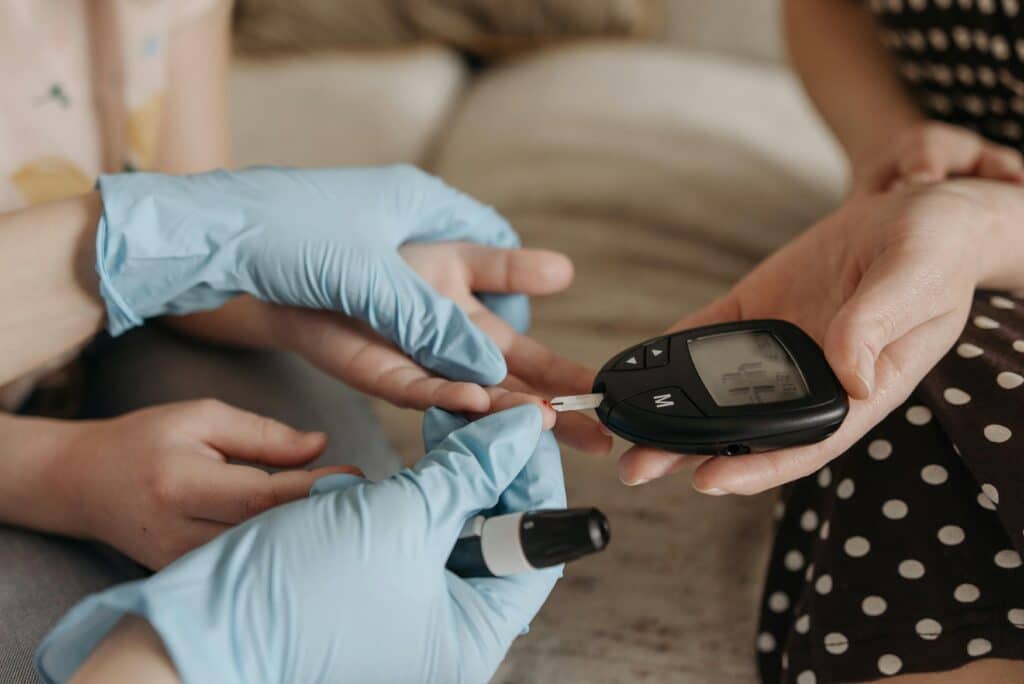Diabetes is a chronic health condition that affects millions of people around the world.
According to the World Health Organization (WHO), about 422 million people worldwide suffer from diabetes and that number will double by 2045.
(No coincidence when you match those numbers up against the global obesity crisis!)
People with diabetes can’t produce enough insulin and/or their bodies can’t use insulin properly.
This leads to excess blood sugar in their bloodstream, resulting in serious health problems such as kidney disease, heart disease, and vision loss over time.
While there isn’t a cure yet, various treatments are available that can help manage blood sugar levels and keep serious health problems at bay.
A promising approach that involves few to no side effects is the use of peptides for diabetes, especially when paired with an insulin-controlled diet and exercise.
If you want to avoid the side effects of other diabetes-treating medications while receiving their benefits through another modality…
Read on to explore the benefits of peptides for diabetes, whether you’re dealing with type 1 and/or type 2 diabetes.
We’ll also provide you with our top four recommended peptides for diabetes treatment that are proven to be effective in addressing both disease states.
Table of Contents
TogglePeptides and Treatment of Diabetes

Peptide therapy has become one of the popular treatment options for people with diabetes.
Peptides can manage diabetes through numerous mechanisms: Stimulating the natural production of insulin (which is a peptide itself), controlling blood sugar levels, and reducing insulin resistance in the body.
They are also believed to promote the production of new insulin-producing cells, regenerate damaged cells, and help prevent cell death.
All of the above benefits not only help regulate blood glucose levels and boost insulin sensitivity, but also reduce one’s risk of diabetes-related complications (blindness, nerve damage, kidney damage, etc.).
Common Diabetes Symptoms

Diabetes occurs in one of two conditions:
- The pancreas fails to produce enough insulin, or…
- The body cannot effectively use the insulin it secretes.
Diabetes can be classified as either type 1 or type 2 diabetes.
In type 1 diabetes, your body cannot properly produce and secrete insulin because the insulin-producing pancreatic β-cells are damaged.
This accounts for roughly 5% of all diagnosed cases of diabetes, and these individuals require daily insulin injections to function normally.
In type 2 diabetes, the body cannot produce sufficient insulin and/or does not respond effectively to insulin.
This condition is best known as “insulin resistance” and can be influenced by both genetics and poor epigenetic (lifestyle) choices (ex. obesity, poor nutrition, and lack of physical exercise).
Common symptoms suffered by diabetics include:
- Feelings of tiredness/fatigue, irritability, and/or weakness
- Thirst (dehydration)
- Frequent urination
- Elevated levels of hunger
- Slower healing of wounds
- Blurred vision
While traditional treatments like insulin and oral hypoglycemic agents can be effective, they also pose risks and may cause unwanted side effects.
Peptide therapy for diabetes (when used alongside healthy eating and regular exercise) offers promising results without the side effect profile of traditional treatments.
In the next section, we’ll cover the most evidence-backed peptides for diabetes treatment and management.
Peptide-Based Therapies in Diabetes Management

Here are our top four recommendations for peptide-based therapies to support healthy blood sugar levels and combat insulin resistance in people with diabetes.
GLP-1 Receptor Agonists (GLP-1 RAs)
A glucagon-like peptide-1 receptor agonist, or GLP-1 RA, mimics the action of the body’s natural GLP-1 hormone.
GLP-1 is an incretin hormone secreted by the intestine whenever we eat, and plays an important role in glucose homeostasis.
It does so by stimulating insulin secretion, stopping glucagon release, and slowing gastric emptying… all of which promote feelings of satiety.
GLP 1 receptor agonists, also referred to as glucose-lowering medications, are commonly used by people with type 2 diabetes mellitus to help manage their blood sugar levels.
They also promote weight loss and help minimize possible cardiovascular risk factors (heart failure, for instance).
Two of the most-used GLP-1 receptors today are Semaglutide and Exenatide.
(NOTE: This is referring to medications that ONLY target GLP-1)
Semaglutide is approved by the U.S. Food and Drug Administration (FDA) under the brand names Rybelsus (oral pill) and Ozempic (subcutaneous injection) for managing type 2 diabetes.
When combined with a healthy diet and exercise program, the peptide helps with both weight loss and blood sugar management.
In a study published in the Journal of Diabetes, Obesity and Metabolism, patients with type 2 diabetes given Semaglutide once a week had reduced blood sugar levels by 1.01 to 1.38%:
“A total of 6 placebo-controlled and 7 active-controlled studies with subcutaneous semaglutide were included. We identified only 1 trial with oral semaglutide.
Compared with placebo, subcutaneous semaglutide 0.5 and 1 mg reduced HbA1c by 1.01% (95% CI, 0.56-1.47) and 1.38% (1.05-1.70), respectively.
Both doses demonstrated superior glycaemic efficacy compared to other antidiabetic agents, including sitagliptin, exenatide, liraglutide, dulaglutide and insulin glargine. Semaglutide also had a beneficial effect on body weight (mean difference vs placebo −4.11 kg, 95% CI −4.85 to −3.37 for semaglutide 1 mg) and systolic blood pressure.
We did not observe increased hypoglycaemia rates with semaglutide; nevertheless, we noted an increased incidence of nausea, vomiting and diarrhoea.
Cases of pancreatitis were infrequent and the odds ratio for diabetic retinopathy compared with placebo was 1.32 (95% CI, 0.98-1.77).
Semaglutide is a potent once-weekly GLP-1 RA, significantly reducing HbA1c, body weight and systolic blood pressure.
However, it is associated with increased incidence of gastrointestinal adverse events. Results for pancreatitis and retinopathy require further assessment in post-approval pharmacovigilance studies.”
In another study, test subjects with type 2 diabetes who were given oral Semaglutide once daily for 4 weeks saw reduced body fat mass, improved eating control, and increased satiety and fullness after a fat-rich breakfast:
“In this randomized, double‐blind, placebo‐controlled, two‐period crossover trial, 15 subjects with T2D received 12 weeks of treatment with once‐daily oral semaglutide (4‐week dose escalation from 3 to 7 to 14 mg) followed by placebo, or vice versa.
Energy intake was measured during an ad libitum lunch, evening meal and snack box after a standard breakfast. Appetite ratings were measured using a visual analogue scale after standard and fat‐rich breakfasts. Other assessments included eating and craving control (using the Control of Eating Questionnaire), and changes in body weight and composition.
Following a standard breakfast, total daily ad libitum energy intake was significantly lower (38.9%) with oral semaglutide versus placebo in 13 evaluable subjects (estimated treatment difference, −5096.0 kJ; 95% CI –7000.0, −3192.1; P = .0001).
After a fat‐rich breakfast, there were significant differences in favour of oral semaglutide versus placebo for measures of satiety, hunger and for overall appetite score, with no significant differences following a standard breakfast.
Fewer food cravings and better eating control were seen with oral semaglutide versus placebo. Overall, mean body weight decreased by 2.7 kg with oral semaglutide and 0.1 kg with placebo, mostly attributable to body fat mass loss.
After 12 weeks of treatment, ad libitum energy intake was lower with oral semaglutide versus placebo, resulting in reduced body fat mass, and was associated with increased satiety and fullness after a fat‐rich breakfast, and improved eating control.”
Exenatide is another glucagon-like peptide-1 (GLP-1) receptor agonist approved by the FDA on April 28, 2005 for the treatment of type 2 diabetes.
(For context, Exenatide is the “1st gen” GLP-1 RA approved for treating type 2 diabetes whereas Semaglutide is technically the “6th gen” GLP-1 RA as its FDA approval for diabetes treatment was granted in 2017)
It works by activating the GLP-1 receptor, which increases insulin secretion in the presence of high blood sugar levels. It also reduces glucagon secretion and slows gastric emptying, thereby improving glycemic control.
In a study in the Diabetes Technology & Therapeutics Journal, patients with type 2 diabetes who were given 10 ug of exenatide for 30 weeks showed improvements in glycemic control and body weight:
“The study enrolled patients aged ≥16 years with T2D treated primarily with metformin and sulfonylureas.
Following 30 weeks of randomized treatment with exenatide QW 2 mg or exenatide twice daily 10 μg, patients entered an uncontrolled, open-label, open-ended study phase in which all patients received exenatide QW 2 mg. Restrictions on concomitant medication use were eased over time.
Of the original 295 patients in the intent-to-treat population, 136 (46%) completed 6 years of treatment.
Six-year completers had sustained significant improvements from baseline in glycated hemoglobin (HbA1c; least-squares mean [LSM] change, -1.6%), with 46.3% achieving HbA1c <7.0%, 33.1% achieving HbA1c ≤6.5%, and significant improvements from baseline in fasting plasma glucose (-28 mg/dL) and body weight (-4.2 kg) at 6 years.
The 78 completers who added no glucose-lowering medications had numerically greater body weight reductions than the overall cohort (6-year LSM change, -6.1 kg) with more stability over time.
No unexpected adverse events were observed during 1202.4 patient-years of exposure. Most minor hypoglycemia events occurred with concomitant sulfonylurea use.”
GIP & GLP-1 Dual Agonists
Just like GLP-1, GIP (glucose-dependent insulinotropic peptide) is an incretin hormone that your body releases after you eat to help control your blood sugar levels.
Type 2 diabetes patients have incretin deficiency, which is due to decreased GLP-1 secretion and the insulinotropic action of GIP.
GLP-1/GIP boost and activate incretin, which helps target major markers of metabolic syndrome (hyperglycemia, obesity, dyslipidemia, etc.).
Tirzepatide, which operates under the brand name Mounjaro, is the first and only FDA-approved GIP and GLP-1 receptor agonist also approved by the American Diabetes Association (ADA) as a treatment for adults with type 2 diabetes and obesity.
(NOTE: The brand name Zepbound specifically refers to the FDA approval of Tirzepatide for “chronic weight management in adults with obesity (BMI > 30 kg/m2) or overweight (BMI > 27 kg/m2) with at least one weight-related condition”)
It works by activating both the GLP-1 and GIP receptors in your body, prompting the pancreas to release insulin and regulate your blood sugar levels.
Tirzepatide also signals certain chemicals in the brain to reduce appetite, increase energy expenditure, and prevent ectopic fat deposition.
All three biochemical cascades result in significant weight and fat loss.
In another study in the Journal of Diabetes, Obesity and Metabolism, type 2 diabetes patients given a subcutaneous injection of Tirzepatide once weekly experienced a reduction in blood sugar levels and risk factors compared to the placebo group:
“In this double‐blind, placebo‐controlled study, patients were randomized (1:1:1:1) to receive either once‐weekly subcutaneous tirzepatide or placebo. The tirzepatide dose groups and dose‐escalation regimens were:
12 mg (4 mg weeks 0–3; 8 mg weeks 4–7; 12 mg weeks 8–11), 15 mg‐1 (2.5 mg weeks 0–1; 5 mg weeks 2–3; 10 mg weeks 4–7; 15 mg weeks 8–11) and 15 mg‐2 (2.5 mg weeks 0–3; 7.5 mg weeks 4–7; 15 mg weeks 8–11).
The primary objective was to compare tirzepatide with placebo in HbA1c change from baseline at 12 weeks.
Overall, 111 patients were randomized: placebo, 26; tirzepatide 12 mg, 29; tirzepatide 15 mg‐1, 28; tirzepatide 15 mg‐2, 28.
The mean age was 57.4 years, HbA1c 8.4% and body mass index 31.9 kg/m2.
At week 12, absolute HbA1c change from baseline (SE) was greater in the tirzepatide treatment groups compared with placebo (placebo, +0.2% [0.21]; 12 mg, −1.7% [0.19]; 15 mg‐1, −2.0% [0.20]; 15 mg‐2, −1.8% [0.19]).
The incidence of nausea was: placebo, 7.7%; 12 mg group, 24.1%; 15 mg‐1 group, 39.3%; 15 mg‐2 group, 35.7%. Three patients discontinued the treatment because of adverse events, one from each of the placebo, 12 mg and 15 mg‐1 groups.
Tirzepatide treatment for 12 weeks resulted in clinically significant reductions in HbA1c. This suggests that lower starting doses and smaller dose increments are associated with a more favourable side effect profile.”
INGAP Peptide
Islet transplantation, which involves extracting an islet from a deceased organ donor’s pancreas, helps type 1 diabetes patients reduce their reliance on daily insulin injections.
These transplanted islets can stimulate the production and release of endogenous insulin in the recipient’s body, thereby aiding in blood sugar control.
Peptides, especially islet neogenesis-associated protein (INGAP), have been shown in several studies to boost the insulin output of pancreatic islets and help maximize the impact of grafted cells.
It works by stimulating beta-cell function and viability, providing a form of islet treatment prior to implantation.
However, circulation time and enzyme degradation can limit dosing efficacy.
Fortunately, Canadian researchers have explored novel molecular variants of INGAP-P (i.e. the bioactive core of INGAP) to discover more bioactive forms.
They discovered four variants that showed improvements compared to the placebo.
“We exposed the live islets of five donors to varying glucose concentrations with INGAP-P variants in solution.
We identified four peptide variants (I9, I15Tyr, I19 and I15Cys) which displayed statistically significant enhancements over negative controls (representing a 1.6-2.8-fold increase in stimulation index).
This is the first study that has assessed these INGAP-P variants in human islets.
It highlights the potential for customized peptides for type 1 diabetes therapy and provides a foundation for future peptide-screening experiments.”
In a separate study involving diabetic rodents, researchers treated streptozotocin-induced diabetic mice that exhibited signs of peripheral neuropathy with either INGAP peptide alone or in combination with insulin.
Results showed that the INGAP peptide can help with nerve regeneration, enhancing nociceptive dysfunction in the peripheral nervous system:
“Following a 2-wk treatment period, thermal hypoalgesia in diabetic mice was significantly improved in groups that received INGAP peptide, without development of hyperalgesia.
Explanted dorsal root ganglia (DRG) from these groups showed enhanced nerve outgrowth and evidence of increased mitochondrial activity.
Western blotting experiments revealed attenuation of neurofilament hyperphosphorylation, up-regulation of beta-tubulin and actin, and increased phosphorylation of the transcription factor STAT3 in DRG.
These findings suggest that INGAP peptide can activate some of the signaling pathways implicated in nerve regeneration in sensory ganglia, thereby providing a means of improvement of nociceptive dysfunction in the peripheral nervous system.”
Pa496h and Pa496m
As we age, the activity of the body’s mitochondria can decrease, leading to the buildup of harmful biochemicals and potentially causing weight gain.
Mitochondria in all mammals fuse and split to keep cells healthy. However, aging and obesity can affect how well they function.
Moreover, there’s no way to promote mitochondrial fission without causing mitochondrial damage and reduced nutrient metabolism.
That’s where two AMPK-targeting peptides, pa496h and pa496m, come in.
These peptides block negative phosphorylation (i.e. the attachment of a phosphate group to a molecule) of AMPK at serine 496.
Pa496h and pa496m prompt mitochondrial fission, especially in people with obesity, diabetes, and age-related metabolic disorders.
This process removes damaged mitochondria, leading to a greater number of functioning mitochondrial while promoting better mitochondrial function.
It also reduces the presence of harmful substances like reactive oxygen species that can damage cells.
As per Ling He, associate professor of pediatrics and pharmacology at the John Hopkins University School of Medicine…
“Our experiments show our targeting peptides can not only enhance and restore mitochondrial function, but also improve their high blood glucose levels, potentially making it particularly valuable for elderly individuals struggling with obesity and diabetes by lowering blood sugar levels.”
Obese mouse models and obese patients with hepatocytes given pa496h and pa496m demonstrated limited excessive glucose production in liver hepatocytes, which is the major reason for high blood glucose levels in people with diabetes and obesity:
“We report that elevated blood insulin and/or glucagon levels downregulate mitochondrial fission through directly phosphorylating AMPKα at S496 by AKT or PKA, resulting in the impairment of AMPK-MFF-DRP1 signaling and mitochondrial dynamics and activity.
Since there are significantly increased AMPKα1 phosphorylation at S496 in the liver of elderly mice, obese mice, and obese patients, we, therefore, designed AMPK-specific targeting peptides (Pa496m and Pa496h) to block AMPKα1S496 phosphorylation and found that these targeting peptides can increase AMPK kinase activity, augment mitochondrial fission and oxidation, and reduce ROS, leading to the rejuvenation of mitochondria.
Furthermore, these AMPK targeting peptides robustly suppress liver glucose production in obese mice. Our data suggest these targeting peptides are promising therapeutic agents for improving mitochondrial dynamics and activity and alleviating hyperglycemia in elderly and obese patients.”
Side Effects and Risks of Peptides for Diabetes

Just like any other therapeutic approach, using peptide therapy for diabetes management comes with possible risks and side effects.
Some of the common side effects people experience when using peptide therapy include:
- Allergic reactions
- Bleeding or bruising at the injection site
- Dizziness, and
- Headaches
However, these are very rare in frequency and meaningless in severity when they are used properly at reasonable doses.
As always… to avoid the risk of serious complications, make sure to disclose any pre-existing health conditions, medications, and allergies with your doctor.
Jay’s Closing Thoughts
To be completely honest, the only two peptides for diabetes I feel comfortable recommending out of this list are Semaglutide and Tirzepatide.
I AM a user of both GLP-1 RAs for nearly four years and have seen thousands of anecdotal testimonials coming from people who have used them successfully.
Not just for the treatment of diabetes, cardiovascular disease or even modifying behavior for positive change in the context of things like excess drinking and shopping…
… but to also help eviscerate stubborn body fat in already-lean people who are seeking a powerful appetite-suppressing agent.
Add on the multiple large-scale clinical trials consistently proving their effectiveness for both diabetics and non-diabetics seeking to lose weight, and you have what is a “revolution” in treating a century-old disease state.
Could Pa496h/Pa496m and INGAP-P have the potential to outrival the GLP-1 RAs for reversing Type 1/2 diabetes?
At this point, nothing is out of the realm of possibility.
But I AM not going to hold my breath until I see more evidence in the medical literature and (hopefully) meaningful trials in human subjects.
The Future of Peptide Therapeutics in Diabetes Care

Using peptides for diabetes is a promising new approach to this common affliction that offers more personalized treatments in the form of oral pills, subcutaneous injections, and synergistic combinations with other peptides.
Peptides also have fewer side effects compared to other traditional treatments, making them a superior choice for the management of diabetes.
However, it’s important to work closely with a knowledgeable optimization doctor in order to create a treatment plan that fits your needs.
More importantly, make sure you are procuring your peptides from trusted sources like Limitless Life Nootropics because they are the biohacking industry’s only reliable vendor for 3rd-party tested research products.
They have the best research formulation of peptides for diabetes (Semaglutide, Tirzepatide, and Retatrutide) available and no other vendor comes close to offering them at ultra-high levels of purity for reasonable prices.
To get your hands on them, you must FIRST be a member of the free-to-join JayC VIP Insider group.
CLICK HERE to Become a Member!
Already A Member? CLICK HERE to Log In & Purchase
But before you start injecting these peptides into your body recklessly, make sure you first read the Top 10 Mistakes People Make When Starting Therapeutic Peptides FREE PDF!
Seriously, this short e-book will save you a lot of wasted money and poorly spent time (not to mention preventing you from potential self-inflicted missteps).
And the emails I’ll send you after downloading the book contain an EXCLUSIVE 33% OFF code for my Peptides Demystified Course, so don’t miss out!
Raise Your Vibration To Optimize Your Love Creation!
PS — Are you looking to maintain healthy blood sugar levels through the smart use of therapeutic peptides and other Golden Age agents?
Join me and hundreds of other male and female biohackers in The Fully Optimized Health Private Membership Group to learn how you can use peptides to support healthy blood sugar levels and optimize your health in your 30s and beyond
We’re excited to discuss biohacking, health, and life optimization through peptide therapy with you.
See you on the other side!



